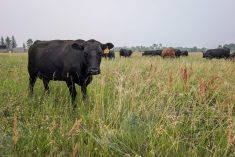Chicago | Reuters — Chicago soybean futures gained on Friday as U.S. trade talks with China continued, invigorating hopes the top soybean importer would reach earlier export estimates.
Wheat fell as the U.S. winter wheat harvest progressed, while corn inched higher on technical positioning.
The most active soybean futures on the Chicago Board of Trade added 3-1/2 cents to end at $8.76-1/2 per bushel after reaching $8.80-1/2, the highest since April 1 (all figures US$).
Wheat fell 2-1/4 cents to $4.81-1/4 per bushel, up from $4.76, the lowest since Sept. 12, while corn gained 1-1/2 cents to $3.32-1/2 per bushel.
Read Also

Field-by-field mapping could improve yield, productivity predictions
University of Saskatchewan researchers are using field border mapping to collect data on field variability, including problematic weeds, and to predict things like yields.
For the week, CBOT July wheat dropped 4.13 per cent, the biggest one-week slump since the week ending May 15. July soybeans gained 0.6 per cent, while July corn ended 0.76 per cent higher.
Talks this week between U.S. and Chinese officials encouraged hopes that Beijing would continue to buy U.S. farm goods as called for under a trade agreement.
However, fresh threats by U.S. President Donald Trump to cut ties with China put tensions back in the spotlight.
“There’s optimism in additional sales to China,” said Bill Lapp, ag economist at Advanced Economic Solutions.
Wheat fell for the fourth straight day as rains across Europe assuaged worries after a dry spring and an advancing U.S. winter wheat harvest that has shown some better than expected yields.
“When we look at the wheat market, this is a tough time for us to sustain a rally, particularly in the first half of the winter wheat harvest,” said Arlan Suderman, chief commodities economist at INTL FCStone.
Corn also gained on technical positioning, Lapp said.
“When they’re this short, and to have this big of a position on, to have an adjustment in the market just should surprise us,” he said.
— Reporting for Reuters by Christopher Walljasper; additional reporting by Gus Trompiz in Paris and Colin Packham in Sydney.

















